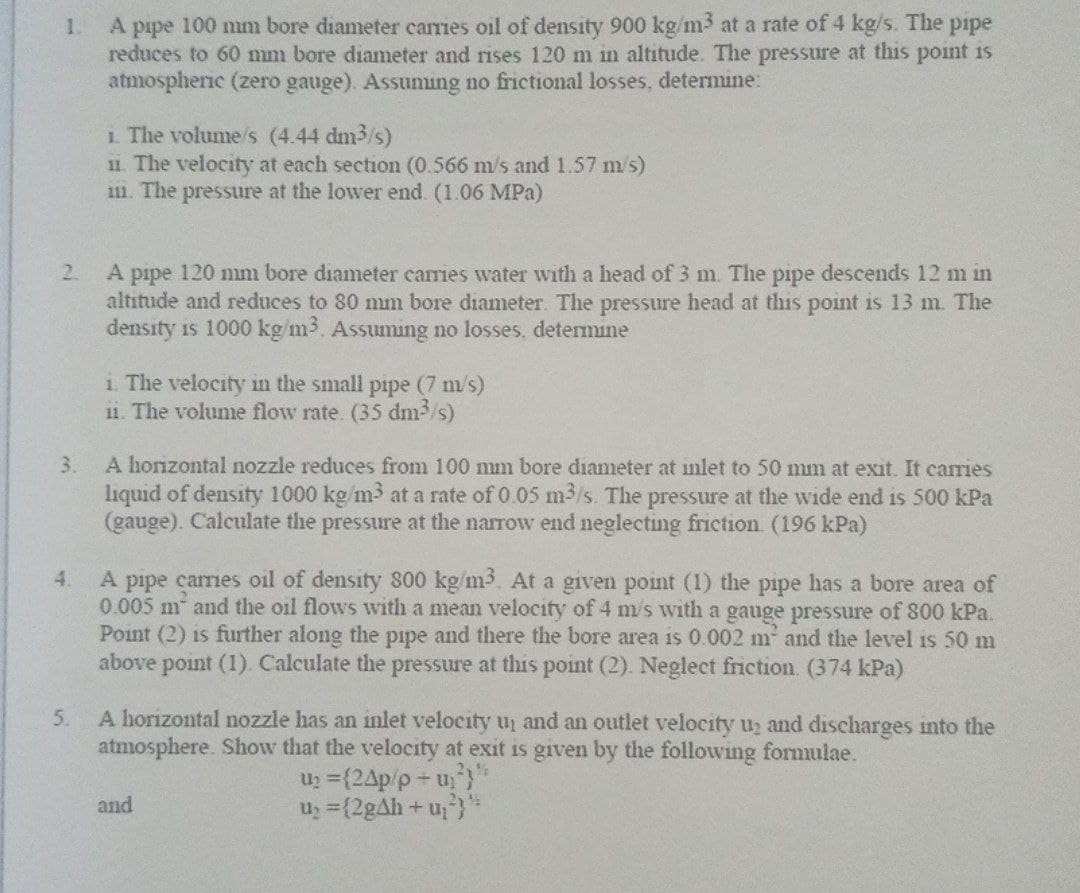1. A pipe 100 mm bore diameter carries oil of density 900 kg/m3 at a rate of 4 kg/s. The pipe reduces to 60 mm bore diameter and rises 120 m in altitude. The pressure at this point is atmospheric (zero gauge). Assuming no frictional losses, determine: i. The volume/s (4.44 dm3/s) 11. The velocity at each section (0.566 m/s and 1.57 m/s) 1. The pressure at the lower end. (1.06 MPa)
1. A pipe 100 mm bore diameter carries oil of density 900 kg/m3 at a rate of 4 kg/s. The pipe reduces to 60 mm bore diameter and rises 120 m in altitude. The pressure at this point is atmospheric (zero gauge). Assuming no frictional losses, determine: i. The volume/s (4.44 dm3/s) 11. The velocity at each section (0.566 m/s and 1.57 m/s) 1. The pressure at the lower end. (1.06 MPa)
Elements Of Electromagnetics
7th Edition
ISBN:9780190698614
Author:Sadiku, Matthew N. O.
Publisher:Sadiku, Matthew N. O.
ChapterMA: Math Assessment
Section: Chapter Questions
Problem 1.1MA
Related questions
Question

Transcribed Image Text:1.
A pipe 100 mm bore diameter carries oil of density 900 kg/m³ at a rate of 4 kg/s. The pipe
reduces to 60 mm bore diameter and rises 120 m in altitude. The pressure at this point is
atmospheric (zero gauge). Assuming no frictional losses, determine:
i. The volume/s (4.44 dm³/s)
11. The velocity at each section (0.566 m/s and 1.57 m/s)
1. The pressure at the lower end (1.06 MPa)
2.
A pipe 120 mm bore diameter carries water with a head of 3 m. The pipe descends 12 m in
altitude and reduces to 80 mm bore diameter. The pressure head at this point is 13 m. The
density is 1000 kg/m³. Assuming no losses, determine
i. The velocity in the small pipe (7 m/s)
ii. The volume flow rate. (35 dm³/s)
3.
A horizontal nozzle reduces from 100 mm bore diameter at inlet to 50 mm at exit. It carries
liquid of density 1000 kg/m³ at a rate of 0.05 m³/s. The pressure at the wide end is 500 kPa
(gauge). Calculate the pressure at the narrow end neglecting friction (196 kPa)
4.
A pipe carries oil of density 800 kg/m3. At a given point (1) the pipe has a bore area of
0.005 m and the oil flows with a mean velocity of 4 m/s with a gauge pressure of 800 kPa.
Point (2) is further along the pipe and there the bore area is 0.002 m² and the level is 50 m
above point (1). Calculate the pressure at this point (2). Neglect friction (374 kPa)
5.
A horizontal nozzle has an inlet velocity up and an outlet velocity u₂ and discharges into the
atmosphere. Show that the velocity at exit is given by the following formulae.
U₂ = {24p/p+u²}"
and
U₂ = {2g4h+u₂²)*
Expert Solution
This question has been solved!
Explore an expertly crafted, step-by-step solution for a thorough understanding of key concepts.
Step by step
Solved in 2 steps with 1 images

Knowledge Booster
Learn more about
Need a deep-dive on the concept behind this application? Look no further. Learn more about this topic, mechanical-engineering and related others by exploring similar questions and additional content below.Recommended textbooks for you

Elements Of Electromagnetics
Mechanical Engineering
ISBN:
9780190698614
Author:
Sadiku, Matthew N. O.
Publisher:
Oxford University Press

Mechanics of Materials (10th Edition)
Mechanical Engineering
ISBN:
9780134319650
Author:
Russell C. Hibbeler
Publisher:
PEARSON

Thermodynamics: An Engineering Approach
Mechanical Engineering
ISBN:
9781259822674
Author:
Yunus A. Cengel Dr., Michael A. Boles
Publisher:
McGraw-Hill Education

Elements Of Electromagnetics
Mechanical Engineering
ISBN:
9780190698614
Author:
Sadiku, Matthew N. O.
Publisher:
Oxford University Press

Mechanics of Materials (10th Edition)
Mechanical Engineering
ISBN:
9780134319650
Author:
Russell C. Hibbeler
Publisher:
PEARSON

Thermodynamics: An Engineering Approach
Mechanical Engineering
ISBN:
9781259822674
Author:
Yunus A. Cengel Dr., Michael A. Boles
Publisher:
McGraw-Hill Education

Control Systems Engineering
Mechanical Engineering
ISBN:
9781118170519
Author:
Norman S. Nise
Publisher:
WILEY

Mechanics of Materials (MindTap Course List)
Mechanical Engineering
ISBN:
9781337093347
Author:
Barry J. Goodno, James M. Gere
Publisher:
Cengage Learning

Engineering Mechanics: Statics
Mechanical Engineering
ISBN:
9781118807330
Author:
James L. Meriam, L. G. Kraige, J. N. Bolton
Publisher:
WILEY